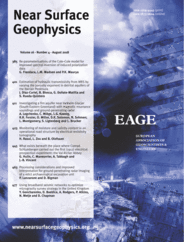
Full text loading...
Moisture dynamics in road systems significantly affect road structure design and maintenance. This study analysed moisture dynamics in a cross‐section of motorway (the E18) in Sweden during a 1‐year period through in situ monitoring using electrical resistivity tomography (ERT). The monitoring methodology was assessed since resistivity can provide a good proxy for monitoring moisture in the road structure. Monthly electrical resistivity was calculated by inverting resistivity data along a pre‐installed electrical resistivity line beneath the surface asphalt layer of the road at the test site. The electrical resistivity data were then statistically analysed and correlated with local climate data, that is precipitation and temperature, and with ground parameters such as moisture content. The results showed high variation in resistivity in the road surface layer and road shoulders depending on weather conditions, water flow and other surface activities. In general, negative correlations between electrical resistivity and precipitation were observed. The results also indicated possible retardation of de‐icing salt after accumulating in the top layer during winter. These findings advance understanding of the moisture dynamics in roads and can help improve pavement design in response to future climate change.

Article metrics loading...

Full text loading...
References


Data & Media loading...

